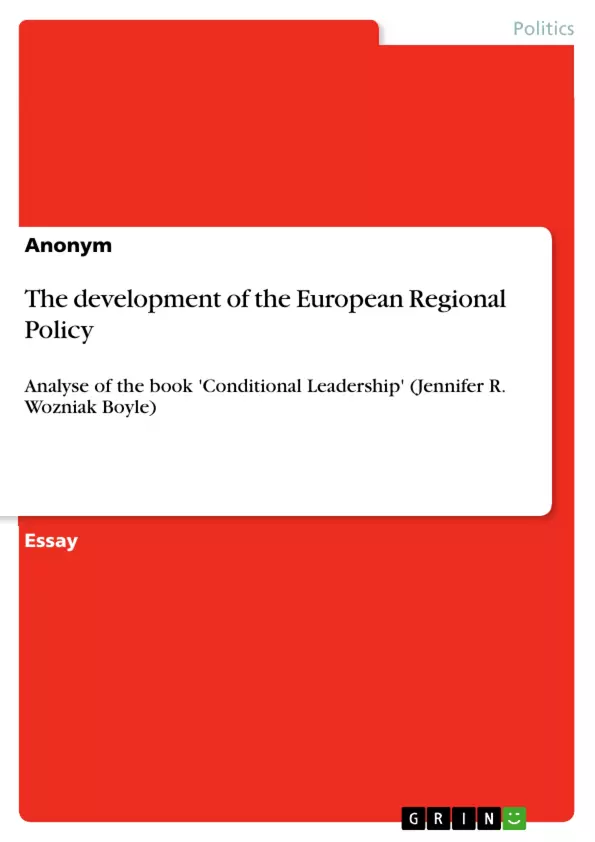he Regional Policy is the second spending of the European Union (347 Billion € for 2007-2013) after the Common Agricultural Policy (CAP).
Since the Rome Treaty of 1957, one of the main role of the community is “to promote harmonious development of economic activities”.
That is one of the main reason of the creation and the elaboration of a common regional policy.
The importance of this policy is also reminded at the time of each enlargement of the European Union, to permit the new member states to make up their development and to fill the different European requirements.
In the first part of this essay, I will try to critically analyse the history of the development of European Regional Policy as made by Jennifer R. Wozniak Boyle in her book : “Conditional Leadership – the European Commission and European Regional Policy”.
I will assess the development to regional policy using evidence relating to three countries studied in class :
Belgium, because it was one of the founding member states of Europe, then Greece because this country became member state in 1981 and was, before 2004 and still is one of the main beneficiary of the funds for regional development and then Slovenia because this state was one of the 10 new member states of the 2004 enlargement which moved deeply the European Regional Policy.
Inhaltsverzeichnis (Table of Contents)
- Introduction
- The Evolution of European Regional Policy
- The Role of the European Commission
- The Reform of 1979
- The Reform of 1985
- The Reform of 1989
- The Reform of 1993
- The Reform of 1999
- The European Regional Policy in Three Case Studies
- Belgium
- Greece
- Slovenia
- Conclusion
Zielsetzung und Themenschwerpunkte (Objectives and Key Themes)
This essay aims to critically analyse the historical development of European Regional Policy (ERP), focusing on the role of the European Commission in shaping and implementing these policies. The analysis is based on the book “Conditional Leadership” by Jennifer R. Wozniak Boyle, which provides a detailed account of the Commission's influence throughout various reform periods.
- The evolution of European Regional Policy and its key milestones
- The role of the European Commission in driving and shaping regional policy reforms
- The relationship between the Commission and member states in the context of regional policy
- The impact of European Regional Policy on various countries, including Belgium, Greece, and Slovenia
- The effectiveness of European Regional Policy in addressing regional disparities and promoting convergence
Zusammenfassung der Kapitel (Chapter Summaries)
- The essay begins by providing an overview of the historical development of European Regional Policy, starting with the establishment of the European Regional Development Fund (ERDF) in 1969. It highlights the key reforms that occurred in 1979, 1985, 1989, 1993, and 1999, focusing on the Commission's role in shaping and implementing these changes.
- The essay then examines the reform of 1979, emphasizing its significance in strengthening the common regional policy, increasing the budget, and enhancing the Commission's control over the funds. It highlights the introduction of the program approach and regional programming documents as measures to improve synchronization and harmonization within member states.
- The essay continues by analyzing the reform of 1985, a period marked by significant changes in the European Union, including the integration of Greece and the accession negotiations with Spain and Portugal. It highlights the Commission's success in abolishing the quota system, expanding the program approach, and increasing its control over national allocations. The essay also emphasizes the increased involvement of regional and local authorities in decision-making and implementation.
- The essay then delves into the reform of 1989, considered the most significant regional policy reform to date. This period was characterized by conflicts between major financial contributors to the European Regional Policy and recipient countries. It highlights the Commission's efforts to move from structural funds to structural policies, with the ERDF representing one-third of the total EU budget.
- The essay examines the reform of 1993, which occurred shortly after the adoption of the Maastricht Treaty. While not as transformative as previous reforms, it serves as a relevant example of the ongoing debate between intergovernmentalists and supranational-institutionalists regarding the control over structural funds. The essay argues that the Commission maintained its superiority due to its central role in initiating, negotiating, and implementing the reform.
Schlüsselwörter (Keywords)
The essay focuses on the key themes of European Regional Policy, the European Commission's role in shaping and implementing regional policy, the historical development of regional policy reforms, and the impact of regional policy on various countries, particularly Belgium, Greece, and Slovenia. It explores concepts such as intergovernmentalism, supranational institutionalism, convergence, and regional disparities.
- Quote paper
- Anonym (Author), 2009, The development of the European Regional Policy, Munich, GRIN Verlag, https://www.grin.com/document/146710



